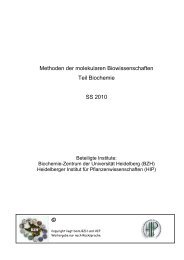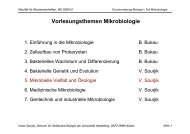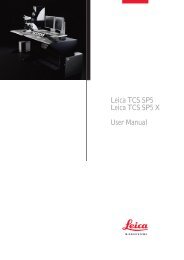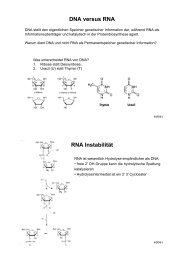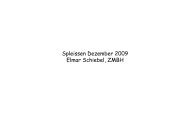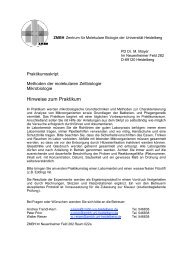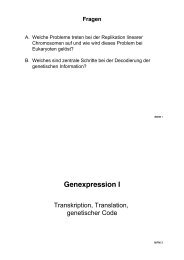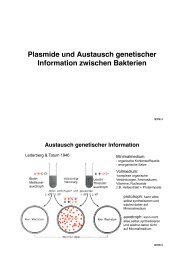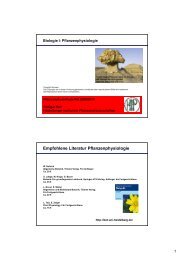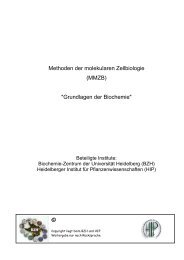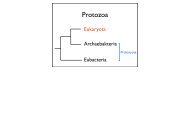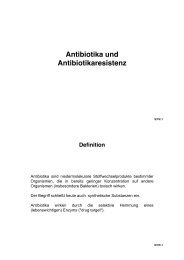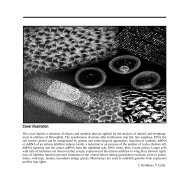ZMBH J.Bericht 2000 - Zentrum für Molekulare Biologie der ...
ZMBH J.Bericht 2000 - Zentrum für Molekulare Biologie der ...
ZMBH J.Bericht 2000 - Zentrum für Molekulare Biologie der ...
You also want an ePaper? Increase the reach of your titles
YUMPU automatically turns print PDFs into web optimized ePapers that Google loves.
expression of misfolded PLP is „toxic“ to myelinforming<br />
oligodendrocytes. Jimpy mice can not be<br />
„rescued“ by transgenic complementation with a wildtype<br />
PLP transgene. Moreover, mice which completely<br />
lack expression of PLP or any truncated<br />
polypeptide (a null allele created by gene targeting)<br />
develop normal motor functions and show no signs<br />
of abnormal glial cell death. In fact, CNS myelin is<br />
assembled as a multilamellar and compacted structure<br />
in the absence of PLP. Although the overall stability<br />
of such PLP-deficient myelin appears reduced, these<br />
observations question the view that the major mem-<br />
Figure 1. Mutations of the gene for myelin proteolipid<br />
protein (PLP) cause Pelizaeus-Merzbacher Disease and<br />
severe dysmyelination in PLP-transgenic mice. The molecular<br />
pathomechanism, which is associated with abnormal<br />
protein trafficking, is poorly un<strong>der</strong>stood. We are using confocal<br />
microscopy to study the intracellular localisation and<br />
export of myelin proteins into the processes of cultured oligodendrocytes.<br />
The folding-sensitive O10-epitope of PLP<br />
(in green) which is lacking in all mutant PLP isoforms<br />
emerges after the C-terminal epitope (in red) of newly synthezised<br />
PLP (provided by E. Krämer).<br />
92<br />
brane protein of CNS myelin is essential to obtain<br />
myelin membrane adhesion and compaction. Recent<br />
evidence suggest that PLP deficiency has profound<br />
effects on axonal integrity which becomes clinically<br />
manifest in aged mice with signs of „neuroaxonal<br />
dystrophy“. The basis of the un<strong>der</strong>lying axon-glia<br />
interaction is currently un<strong>der</strong> investigation.<br />
We have expressed PLP cDNAs from natural mouse<br />
mutants in cultured non-glial cells. These studies show<br />
that fibroblasts are much less sensitive to the overexpression<br />
effect and mutant isoforms of PLP than<br />
oligodendrocytes in vivo. However, also transfected<br />
fibroblastoid cells recognize subtle alterations in the<br />
PLP primary structure, because these translation products<br />
are retained inside the cell and do not reach the<br />
cell surface. A direct demonstration of protein misfolding<br />
is also possible with a conformation-sensitive<br />
monoclonal antibody (O10) which distinguishes<br />
wildtype PLP from the known mutant isoforms.<br />
III. Neuronal members of the proteolipid protein<br />
family: M6A and M6B<br />
L. Dimou, M. Klugmann, H. Werner<br />
PLP is the prototype of a small family of sequencerelated<br />
tetraspan membrane proteins which includes<br />
M6A and M6B proteins, abundantly expressed on<br />
neuronal processes in the central nervous system.<br />
M6B is also detectable in oligodendrocytes. There are<br />
multiple M6B-mRNAs, encoding at least eight protein<br />
isoforms. Smaller, presumably soluble polypeptides<br />
result from alternatively spliced M6B mRNAs<br />
with a stop codon upstream of the exon for the first<br />
transmembrane domain. In cells of the oligodendroglial<br />
lineage, M6B localizes to the cell surface and transiently<br />
also on cellular processes. By in situ-hybrid-<br />
ization, oligodendrocytes express one of two alternative<br />
C-termini, whereas cortical neurons express<br />
both. Regulated expression of the various intracellular<br />
domains of M6B, termed α, β, γ, ψ, and ω (some of<br />
which are structurally conserved in M6A and PLP),<br />
suggests that proteolipids can interact with cytoplasmic<br />
proteins present in a variety of neural cell types.<br />
The N-terminal domains of M6B affect transport features<br />
and the subcellular distribution of this protein<br />
when expressed in fibroblasts. The analysis of M6A<br />
and M6B mouse mutants is ongoing and suggests a<br />
role in neuronal process outgrowth and CNS myelination,<br />
respectively.<br />
IV. NEX and NeuroD regulate hippocampal<br />
granule cell differentition<br />
A. Bartholomä, S. Göbbels, M. Rossner, M.<br />
Schwab<br />
Parts of our laboratory‘s activity was devoted to the<br />
function of basic helix-loop-helix (bHLH) proteins in<br />
the nervous system. The neuronal transcription factors<br />
NEX (neuronal helix-loop-helix protein-1), NeuroD<br />
(neurogenic differentiation factor), and NDRF comprise<br />
a family of Drosophila atonal-related bHLH<br />
proteins with highly overlapping expression in the<br />
developing forebrain. A role for NeuroD and NEX<br />
in terminal neuronal differentiation is demonstrated<br />
by mutations in mice. For example, in the hippocampus,<br />
presumptive granule cells of the dentate gyrus<br />
are generated but fail to mature, lack normal sodium<br />
currents, and show little dendritic arborization. Longterm<br />
hippocampal slice cultures reveal secondary<br />
alterations, such as abnormal projections from the<br />
entorhinal cortex. Ongoing experiments aim at restricting<br />
the mutations of the NeuroD gene to subsets of<br />
cortical neurons, utilizing homologous recombination<br />
of the loxP/Cre system. This will allow to circumvent<br />
perinatal lethality and study the role of bHLH proteins<br />
in adult neuronal functions.<br />
Figure 2. Cre-mediated recombination of genes that are<br />
flanked by loxP sites allows the generation of cell type-specific<br />
somatic mutations in transgenic mice. We have utilized<br />
the spatio-temporal expression pattern of the NEX gene<br />
to drive expression of Cre specifically into CNS neurons. A<br />
„knock in“ strategy was chosen, to insert Cre into exon 2 of<br />
the endogenous NEX gene. To demonstrate the specificity of<br />
this system, a lacZ reporter function was specifically activated<br />
by Cre recombination in neurons of the hippocampus<br />
and neocortex of transgenic mice. This mouse is used to<br />
circumvent the perinatal lethality of a null mutation in the<br />
neuroD gene (provided by S. Goebbels).<br />
External Funding<br />
During the period reported our research was supported<br />
by grants from the Deutsche Forschungsgemeinschaft<br />
(SFB 317 “<strong>Molekulare</strong> <strong>Biologie</strong> neuraler Mechanismen<br />
und Interaktionen”, Graduiertenkolleg “<strong>Molekulare</strong><br />
und zelluläre Neurobiologie”) from the BMBF<br />
and from the EU.<br />
93



